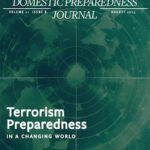- Articles, Communication & Interoperability, Critical Infrastructure
- Charles J. Guddemi
On the night of January 10, 2023, the Federal Aviation Administration’s Notice to Air Missions (NOTAM) system, which communicates real-time hazards to pilots and airports, failed for an unknown reason. The backup communications provided critical updates to pilots but were insufficient to sustain operations. By morning, operations had to cease for two hours while they located and fixed the problem. In the meantime, 1,300 flights were canceled, and 10,000 others were delayed across the United States. Communication failures cannot always be avoided, but organizations must plan what to do when they occur.
Most organizations have a daily operational plan for their communications that works most of the time. When the power goes out or a system goes down, many have a backup plan to get by for the short term until the problem is resolved. Unfortunately, this is where their plans often end. Occasionally, operations slow or even stop while people wait for instructions on what to do next. Military leaders have long known that operations cannot cease during an emergency for any reason, so they use a primary, alternate, contingency, emergency (known as P.A.C.E. or PACE) plan for critical operational planning tasks.
The District of Columbia Homeland Security and Emergency Management Agency (HSEMA), Office of the Statewide Interoperability Coordinator (SWIC), decided to introduce the concept to organizations in the National Capital Region. However, despite an array of business continuity training programs across the country and the Federal Emergency Management Agency’s vast number of courses through its Emergency Management Institute, courses that focused on building PACE plans for civilians were not readily available. To fill this gap, HSEMA reached out to the Emergency Communications Division (ECD) of the Cybersecurity & Infrastructure Security Agency (CISA), which developed a new course and curriculum. CISA conducted its pilot at HSEMA in Washington, D.C., in August 2022. With feedback from the pilot, the course was finalized and opened to organizations throughout the region, with two classes held on January 19 and one on January 20, 2023. As a result of this initial class, ECD is looking to revise this course in 2023 to be rolled out to agencies and organizations nationwide.
Understanding PACE
Unlike many courses, PACE shows trainees how to teach themselves. By understanding what this type of plan is, the communication methods available, and the many causes of system failures, participants can build a pathway to transfer information under any circumstances. As such, PACE’s four-step format should be a component of any communications, continuity of operations, or business continuity plan:
- Primary – This is the go-to method that operations personnel use as a daily solution (e.g., radios for day-to-day operations).
- Alternate – This is a backup method that is not preferred but may serve as a good workaround until the problem is resolved (e.g., a different radio system).
- Contingency – This is a fallback method that uses totally different technology, systems, etc. (e.g., satellite phones).
- Emergency – This is the last-resort method when the others fail (e.g., a runner).

To better understand why a simple backup plan is insufficient, consider how CISA describes the communications ecosystem. This ecosystem is bigger than the planning organization, first responder groups, and the boots on the ground. It also includes connections between these key community stakeholders and more:
- Public to government – Includes 911 (to include Next Generation 911), 311, agency applications that allow feedback, social media, email, landlines, and cellphones;
- Government to government – Includes land mobile radio systems (individual and shared agency), landline phones, cellphones, satellite phone and data systems, alerting applications, special telephone and data connections, email, computer-aided dispatch;
- Government to public – Includes government alerting applications, emergency broadcasting systems, broadcast news media, web pages, email, warning sirens, social media, and in-person outreach; and
- Public to public – Includes cellphones, landlines, emails, social networking, faith-based organizations, schools, youth sports leagues, and neighborhood organizations.
There need to be multiple pathways for each of the above connections (and other applicable connections in a particular area) to ensure daily operability and interoperability. Of course, everyone involved in the ecosystem should also be planning for these contingencies (public, government, industry, media, non-governmental organizations, and communication companies).

Developing the Plan
System failures can occur for numerous reasons, from user errors to intentional attacks. Identifying and reporting the reasons for and locations of failures are critical for pinpointing the problems and regaining normal operations. Regardless of the type of failure, even small details during and after the event are crucial and make a big difference in getting the information rapidly to the right people to resolve the issue as soon as possible.
Be aware of what is occurring behind the scenes to consider all possible failure points and alternatives. This knowledge helps identify resources that can meet the needs and point out the potential limitations of each resource to determine the best PACE plan methods. When the plan is implemented, though, expectations must be realistic. This means that what may be unacceptable during normal operations may become acceptable under the C (Contingency) or E (Emergency) steps in this plan. So, keep that in mind when identifying the various options.
In addition to direct communications, a PACE plan for communications also includes data and other daily operations. Consider what other jobs might not be possible if communications systems were to go down. For example, suppose security operations at a large sporting venue experience a communications failure. In that case, that failure may also affect the ticket scanners where thousands of people are waiting to enter the stadium. Sometimes, these jobs involve life-saving field operations such as law enforcement, emergency medical services, and firefighting when dispatch centers, radio systems, etc. are affected. PACE plans consider these various connections.
Putting the Plan Into Action
Once the PACE plan is complete, all users must learn and understand the plans. To do this, they should have opportunities to train and exercise to ensure they know how to identify when to change from one method to the next. Developers must also regularly review and revise the plan as systems and operations change. Organizations can better mitigate operational disruptions by keeping the plan simple and managing expectations.
Six key questions to ask when a communications failure occurs include:
- What systems, operations, activities, etc. are impacted?
- Who in the ecosystem is affected (public, government)?
- Which resources and methods are affected, and which are available?
- Why are they impacted (identifying the cause can facilitate the solution)?
- Is it time to implement the PACE plan, or is it time to move to the next step in the PACE plan?
If the communications failure hinders necessary public safety or public service activities or puts lives or property in danger, the answer to the last question is yes. Starting with the primary method, work through the alternate, contingency, and emergency stages as needed for each situation. However, since switching to the next step is not intuitive, it must be planned and practiced ensuring all key stakeholders know what to do and under what conditions to change methods. A key challenge to the PACE concept is understanding the trigger point for transition to the next component of the plan. This transition between the sender and receiver of information must occur simultaneously, without the benefit of being choreographed by some communications means. This is why the education, training, and exercise piece is so important. Emergency communications ecosystem participants have to understand that the decision to transition to other parts of the plan may have to occur in a vacuum where communications no longer exist. The alerting, signaling, and coaching that many people are used to getting would be gone!
Finding Helpful Resources
Before beginning any PACE plan, it is good first to find out if an organization already has a PACE plan or has a continuity of operations or business continuity plan that could be used as a platform to develop one. If some work has already been completed or there are resources available from other organizations, build on those by inserting that information into the PACE template rather than starting with a blank page. These templates can be for a single resource (e.g., voice communications), a single organization, or multiple organizations. Think outside the box at what all the possible pathways could be.
The communications ecosystem is bigger than the planning organization, first responder groups, and the boots on the ground.
CISA offers several priority telecommunications services that are helpful for a PACE communications plan. The Government Emergency Telecommunications Services (GETS) provides priority landline access during times of congestion and degradation. The Wireless Priority Service (WPS) also boosts the reliability of calls when communications are congested or degraded. Users can combine GETS and WPS with other services like FirstNet and Frontline to increase priority between carrier services. Finally, the Telecommunications Service Priority (TSP) prioritizes the restoration of voice and data connectivity for organizations with national security and emergency preparedness missions (Note: TSP has a fee and must be set up in advance of the service).
For everyone in the ecosystem, a National Oceanic and Atmospheric Administration (NOAA) weather radio offers an all-hazards network for broadcasting information about all types of natural and environmental hazards (e.g., storms, earthquakes, avalanches, chemical releases, oil spills) and public safety messages (e.g., AMBER alerts, 911 telephone outages).
By taking a fresh look at old continuity plans, preparedness professionals can better assess their communication needs and identify multiple viable solutions to future communication failures. Although this article focuses on communications planning, PACE should be applied to any public safety or public service activities that could put lives or property in danger if any failure were to interrupt those activities.
Lack of PACE awareness was identified as a gap during the 2021 Presidential Inauguration planning process. The preparation plans were rocked in a twelve-day period between the Nashville Christmas Day Bombing and January 6, 2021, insurrection attack on the United States Capitol. Both events challenged operable and interoperable communications, negatively impacting the emergency communications ecosystem.
The message to everyone, whether creating a standard operating procedure or incident response plan, the cop on the beat, firefighter on a ladder truck, paramedic in an ambulance, administrative assistant, teleworker, or homemaker, be sure to “PACE it”!

Charles J. Guddemi
Charles Guddemi is the District of Columbia’s Homeland Security and Emergency Management Agency’s (HSEMA) statewide interoperability coordinator (SWIC). He is responsible for coordinating interoperability and communications projects involving voice, data, and video. He chairs the District’s Interoperable Communications Committee and Cellular Industry/WiFi Provider Working Group. He serves as the secretary for the Statewide Interoperability Executives Council, is a member of the National Council of Statewide Interoperability Coordinators and current co-chair of FEMA’s Region III Regional Emergency Communications Coordinators Working Group. He also participates on several Metropolitan Washington Council of Governments (MWCOG) committees and working groups. He joined HSEMA after a 25-year career with the United States Park Police (USPP). His assignments included working in Washington, D.C., New York Field Office, San Francisco Field Office, and the National Park Service Northeast Regional Headquarters in Philadelphia, Pennsylvania. He achieved the rank of deputy chief serving as the commander of the Services Division.
- Charles J. Guddemihttps://domesticpreparedness.com/author/charles-j-guddemi
- Charles J. Guddemihttps://domesticpreparedness.com/author/charles-j-guddemi
- Charles J. Guddemihttps://domesticpreparedness.com/author/charles-j-guddemi
- Charles J. Guddemihttps://domesticpreparedness.com/author/charles-j-guddemi





